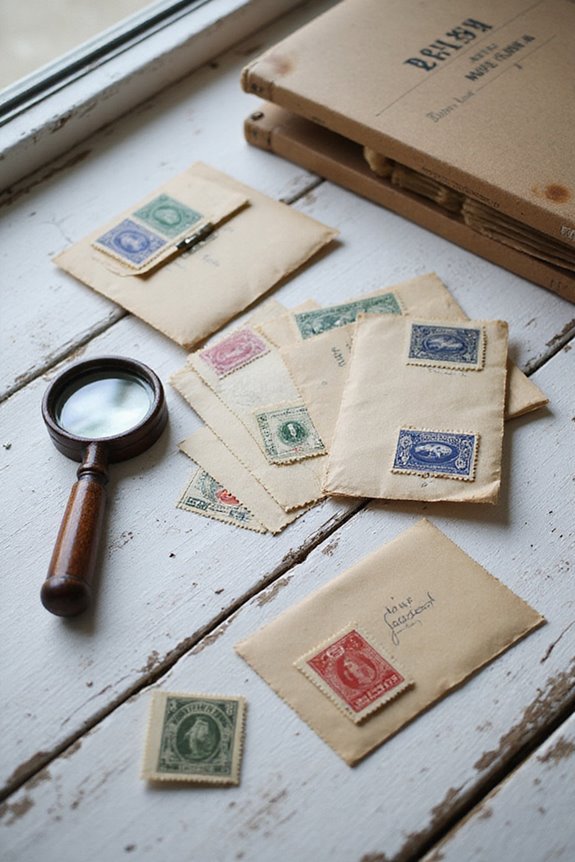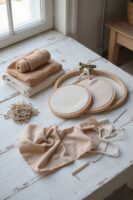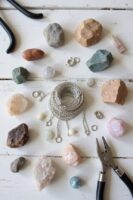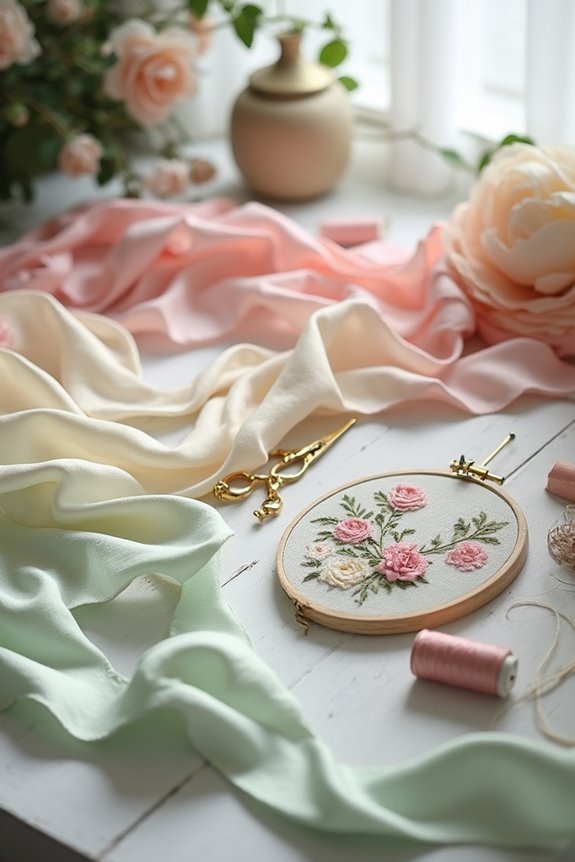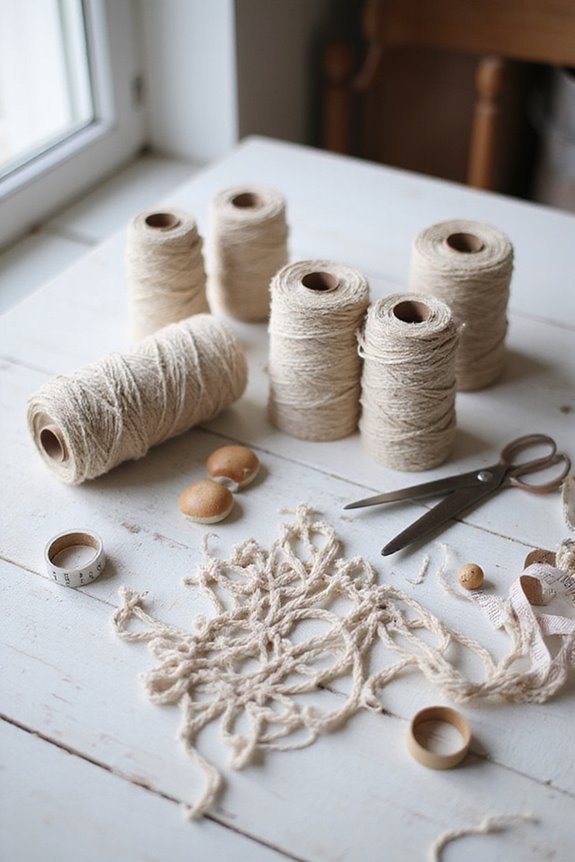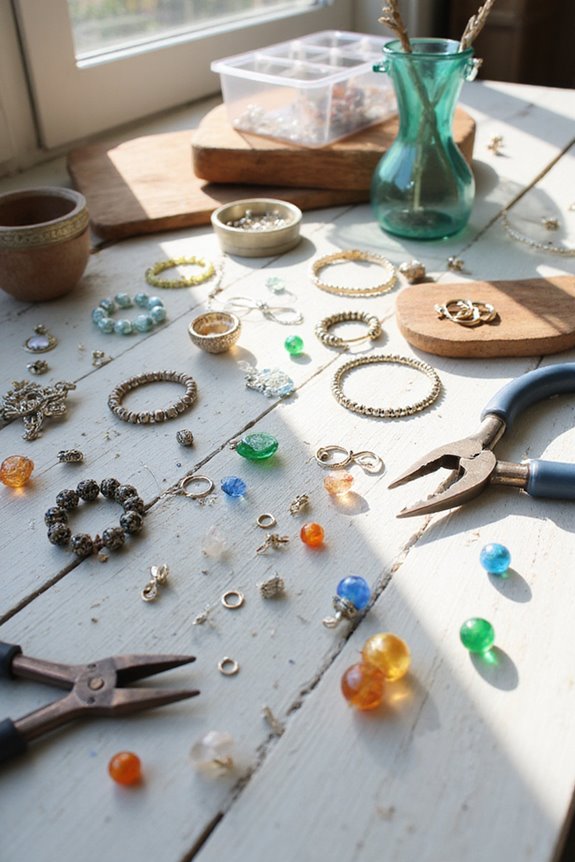As stamp collectors, we love crafting customized envelopes, which add a personal touch to our collections. 📬 We often create thematic displays that showcase our stamps beautifully. Using high-quality stamp mounts helps us preserve our treasures, preventing damage over time. We also enjoy magnifying tools for detailed study, uncovering intricate designs. 🧐 Joining community workshops allows us to brainstorm collaborative projects and trade ideas. If you’re curious about other favorites in our hobby, keep exploring!
Key Takeaways
- Stamp mounting and preservation using high-quality mounts and acid-free albums is a popular craft among collectors.
- Creating thematic collections allows collectors to explore personal interests while crafting unique narratives with their stamps.
- Designing and building custom displays enhances the visual appeal and storytelling aspect of stamp collections.
- Engaging in trade and swap events fosters community connections and provides opportunities for crafting and sharing ideas.
- Participating in crafting workshops or online tutorials helps collectors develop new techniques and refine their skills in stamp-related crafts.
Stamp Album Creation and Organization
Creating and organizing your stamp album can be a rewarding experience, and it really helps to have a solid plan in place. We can start by deciding on an album layout. One effective method is to sort by country or subject, as this creates logical groups for easy access.
When designing pages, using light pencil marks to outline stamp placements guarantees neatness. Also, color-coded binders can enhance organization, allowing for quick identification of different categories.
Don’t forget about storage solutions! Acid-free albums protect stamps from damage, while stockbooks let us store duplicates without permanent mounting. Additionally, considering acid-free materials will ensure long-lasting protection for your collection. Regular reviews of our albums will help maintain order and keep our collections growing beautifully. Happy collecting!
The Art of Stamp Mounting and Preservation
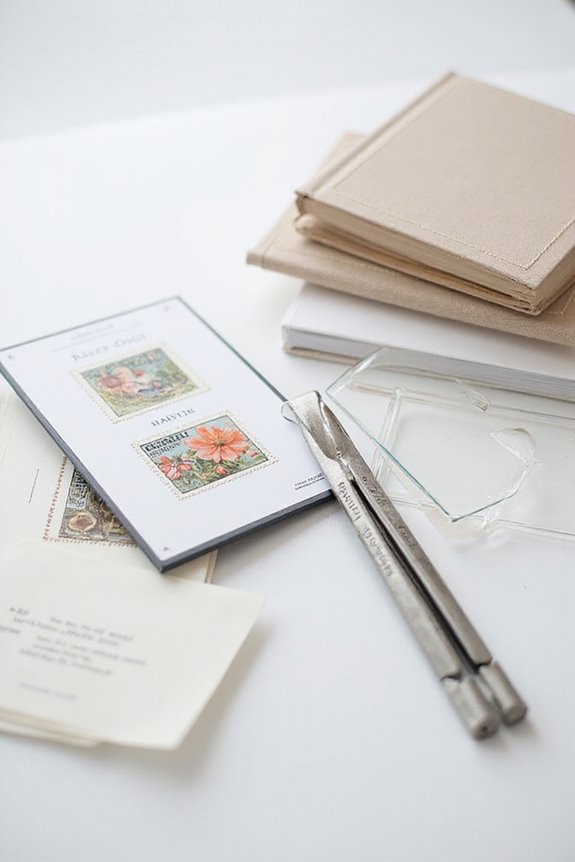
Once your stamp album is organized, we can focus on the art of mounting and preserving those precious stamps. First, we need to guarantee ideal environmental conditions. Keep your stamps in a cool, dark place with a temperature of 65°F to 72°F and aim for 50% humidity.
To mount your stamps, use high-quality stamp mounts to attach them to album pages, preventing damage. Utilizing stamp tongs keeps your fingerprints off, protecting their condition.
For long-term storage, opt for acid-free albums and stock books. Silica gel packs help control moisture levels, while avoiding direct sunlight is essential to prevent fading. Remember, we’re preserving the beauty and value of our collections! 🕵♂✨ Additionally, consider using self-healing cutting mats to protect your work surface while cutting and organizing materials related to your stamp collection.
Engaging in Thematic Collections
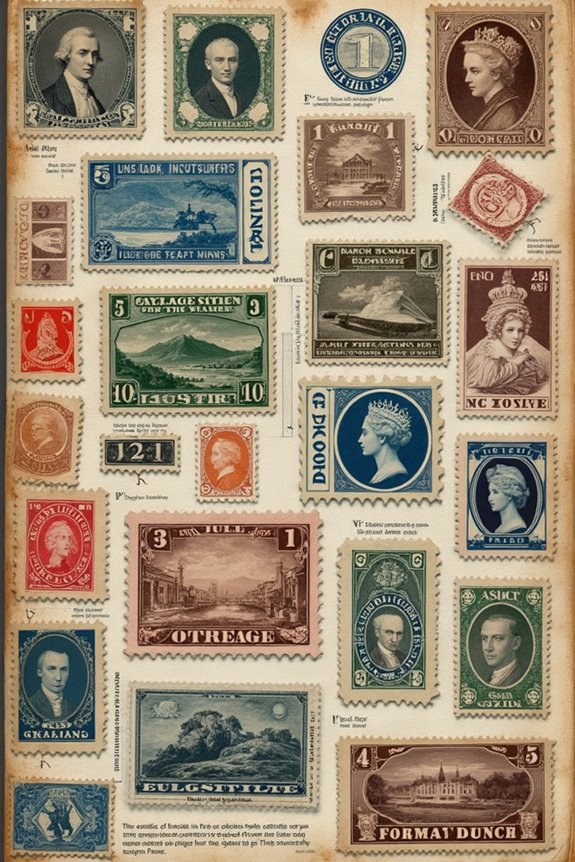
Stamp collecting isn’t just about gathering; it’s a way to tell stories through themes that resonate with our interests. Engaging in thematic collections enriches our collector identity, allowing us to explore subjects we’re passionate about.
- Choose a Theme: Common themes include historical events, art and culture, or nature. Pick what excites you! 🌿
- Research: Immerse yourself in catalogs or online marketplaces to find stamps that fit your theme.
- Be Specific: Consider specializations, like focusing on trains or specific flowers, to create a niche collection.
- Connect with Others: Join online communities for trading and sharing insights.
Additionally, using acid-free materials to store your stamps can help preserve their quality over time. Thematic exploration lets us connect emotionally with the broader world while fostering our unique collector identity. Happy collecting!
Trade and Swap Events Among Collectors
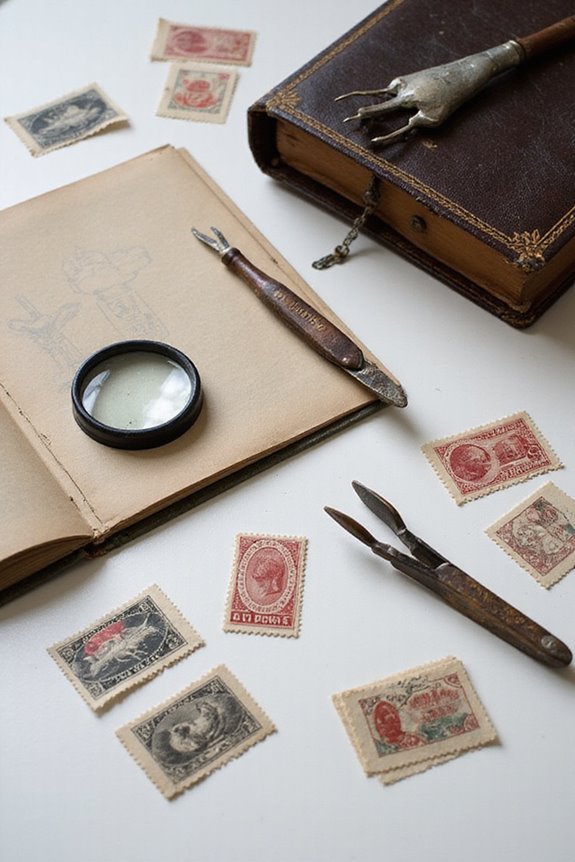
Trade and swap events among collectors offer an exciting opportunity for us to enrich our collections while building community connections. 🖊 These gatherings are perfect for exchanging our duplicate stamps, allowing us to diversify without spending cash.
When attending, it’s essential to know swap etiquette. Be respectful, polite, and transparent about the trade value of your stamps.
Here are a few tips:
- Identify Your Duplicates: Have a clear list of what you’re willing to trade.
- Establish Fair Values: Know the market value but be willing to negotiate.
- Document Trades: Keep a record of what each party exchanges.
Incorporating creative project ideas can also inspire unique ways to display or utilize our stamp collections. Following these guidelines can enhance our experience and strengthen connections within the stamp-collecting community.
Exploring Postal History Through Covers
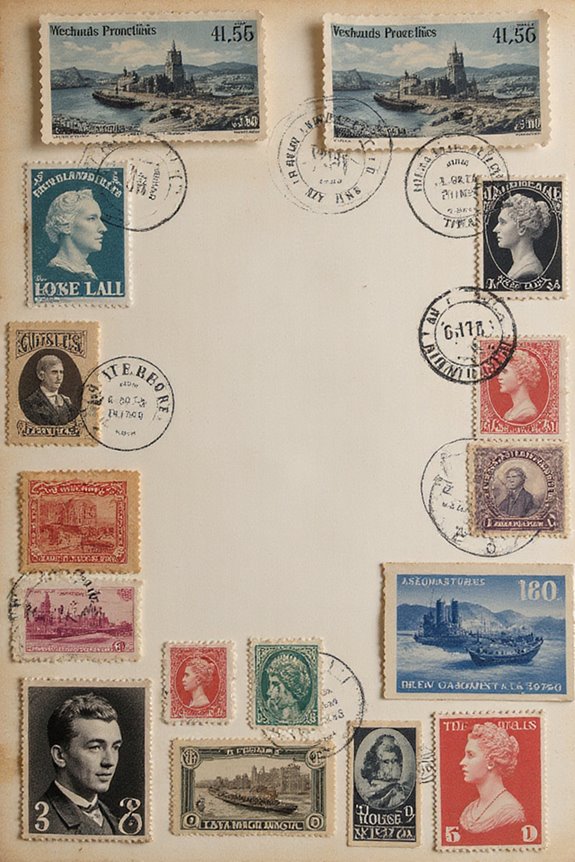
As collectors, we often find ourselves fascinated not just by the stamps we accumulate, but also by the stories told through the envelopes they were sent in—known as covers. 📨 These covers reveal much about postal history, including postal routes and rates.
Here’s how we can explore cover research:
- Examine Postmarks: These date and place stamps are essential for understanding a cover’s journey.
- Look for Backstamps: They show when and where mail was processed, adding layers to the story.
- Trace Routes: Identify destination markings that map the path taken.
Doing this not only enriches our collections but also helps us appreciate the fascinating history behind each cover we encounter. 📚✉ Additionally, using high-quality vinyl options for labeling our covers can enhance their presentation and durability.
Crafting Customized Envelopes for Stamp Sentiment
Creating customized envelopes isn’t just a fun project; it’s a beautiful way to express your personality through the mail. 🎨 We can turn a simple envelope into a canvas, combining techniques and materials that showcase our creative flair.
Start by mixing stamps of various sizes and shapes for unique visual patterns. Using a large focal stamp with smaller accents enhances the aesthetic. Let’s explore stamp layering to add depth by combining different ink colors.
Don’t forget about envelope embellishments! Ribbons, washi tapes, or small stickers can personalize your designs. Experiment with bold inks to make your envelopes POP!
Finally, adopting a mixed-media approach allows us to blend stamping with other crafts. Let’s get creative and delight the recipient! ✉
Utilizing Magnification for Detail Study
When we dig into stamp collecting, magnification can be our best friend for detailed study. 🕵♂ Using a magnifier helps us uncover features that are invisible to the naked eye, such as subtle watermarks and intricate printing details.
- For general inspection, we recommend 5X to 10X magnification.
- When you need to view microprinting features, aim for 8X or higher.
Opt for magnifiers with illumination options to enhance visibility; these can vastly improve our experience by compensating for reduced light caused by the lens. Remember, handheld magnifying glasses are easy to use, while desk-mounted ones are great for lengthy assessments.
Don’t forget to use stamp tongs to protect our precious finds while we’re examining them carefully!
Collaborative Projects in the Stamp Community
While we often think of stamp collecting as a solitary hobby, collaborative projects can deepen our connections to the community and enhance our collecting experience. Collaborative commemorations like the Holocaust Stamps Project demonstrate the power of unity. This initiative gathered 11 million stamps to honor Holocaust victims, transforming them into an emotional exhibit.
Participating in cultural exchanges, such as the Sons of Norway Polar Star Lodge, also enriches our lives. Group projects allow us to explore heritage through stamps and foster intergenerational cooperation.
Enhancing Collections With Display Techniques
Enhancing our stamp collections can be a fun and rewarding journey, especially when we incorporate various display techniques. To create attractive and aesthetic arrangements, we can start using stockbooks or albums that fit our collection sizes—consider options of 8, 16, or 32 pages.
Here are some tips:
- Use acid-free paper and UV-protective glass, preserving stamps while showcasing them.
- Shadow boxes let us display stamps without placing them against glass, so they stay pristine.
- Grouping stamps by theme, like countries or eras, tells a story.
- Consider display cases for protection and three-dimensional effects!
Frequently Asked Questions
What Are the Best Sources for Acquiring Vintage Stamps?
When seeking vintage stamps, we explore online auctions, attend estate sales, and visit philatelic exhibitions or stamp fairs. Each source offers unique finds, enriching our collections while connecting us with fellow enthusiasts and dealers.
How Do I Determine a Stamp’s Market Value?
To determine a stamp’s market value, we should consider current market trends and employ various valuation methods. Evaluating rarity, condition, and historical significance will help us make informed decisions on pricing and collecting.
Which Tools Are Essential for Beginner Stamp Collectors?
For beginner stamp collectors, we need essential tools like stamp tongs, stockbooks, and magnifying glasses. These stamping supplies help us handle, store, and view our treasures while preserving their value for years to come.
What Common Mistakes Should New Collectors Avoid?
As we commence our collecting journey, we must navigate common pitfalls; using reliable collector resources and meticulous record-keeping can elevate our collections. Let’s tread carefully, ensuring our passion shines without costly missteps.
How Can I Sell My Stamp Collection Effectively?
To sell our stamp collection effectively, we should explore stamp auctions and online marketplaces. Leveraging their vast reach and competitive pricing will help us attract buyers and maximize our potential returns on treasured stamps.

